光催化有机合成
光催化反应在有机合成中的应用
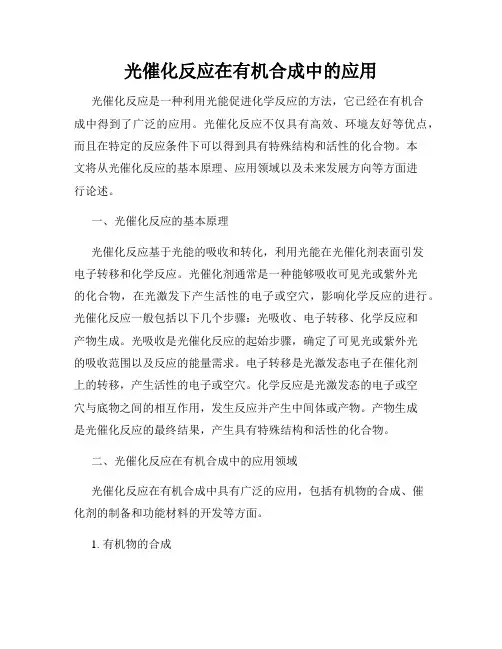
光催化反应在有机合成中的应用光催化反应是一种利用光能促进化学反应的方法,它已经在有机合成中得到了广泛的应用。
光催化反应不仅具有高效、环境友好等优点,而且在特定的反应条件下可以得到具有特殊结构和活性的化合物。
本文将从光催化反应的基本原理、应用领域以及未来发展方向等方面进行论述。
一、光催化反应的基本原理光催化反应基于光能的吸收和转化,利用光能在光催化剂表面引发电子转移和化学反应。
光催化剂通常是一种能够吸收可见光或紫外光的化合物,在光激发下产生活性的电子或空穴,影响化学反应的进行。
光催化反应一般包括以下几个步骤:光吸收、电子转移、化学反应和产物生成。
光吸收是光催化反应的起始步骤,确定了可见光或紫外光的吸收范围以及反应的能量需求。
电子转移是光激发态电子在催化剂上的转移,产生活性的电子或空穴。
化学反应是光激发态的电子或空穴与底物之间的相互作用,发生反应并产生中间体或产物。
产物生成是光催化反应的最终结果,产生具有特殊结构和活性的化合物。
二、光催化反应在有机合成中的应用领域光催化反应在有机合成中具有广泛的应用,包括有机物的合成、催化剂的制备和功能材料的开发等方面。
1. 有机物的合成光催化反应可以在温和的条件下合成一些复杂的有机化合物,而无需使用高温、高压或有毒的试剂。
例如,通过光催化反应可以实现C-C键的形成、碳-氮键的构建以及醇、酮、醛等有机官能团的插入反应。
此外,光催化反应还可以实现手性化合物的合成,通过选择合适的手性催化剂,可以得到具有高立体选择性的手性产物。
2. 催化剂的制备光催化反应可以用于制备高效的催化剂。
例如,通过光催化反应可以合成一些过渡金属配合物,这些配合物在光激发下能够产生活性的反应中间体,促进化学反应的进行。
此外,光催化反应还可以实现一些催化剂的再生和循环利用,减少催化剂的使用量和废弃物的产生。
3. 功能材料的开发光催化反应可以用于开发具有特殊结构和功能的材料。
例如,通过光催化反应可以制备出具有光储能、光吸附和光催化性能的材料,用于太阳能转换、污水处理和环境修复等领域。
光催化技术在有机合成中的应用
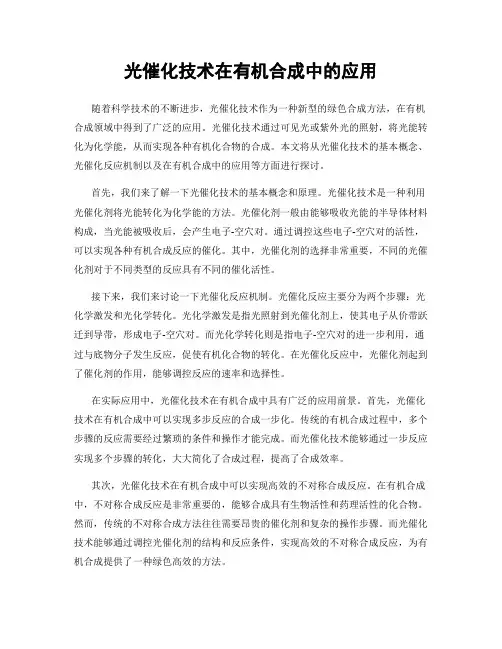
光催化技术在有机合成中的应用随着科学技术的不断进步,光催化技术作为一种新型的绿色合成方法,在有机合成领域中得到了广泛的应用。
光催化技术通过可见光或紫外光的照射,将光能转化为化学能,从而实现各种有机化合物的合成。
本文将从光催化技术的基本概念、光催化反应机制以及在有机合成中的应用等方面进行探讨。
首先,我们来了解一下光催化技术的基本概念和原理。
光催化技术是一种利用光催化剂将光能转化为化学能的方法。
光催化剂一般由能够吸收光能的半导体材料构成,当光能被吸收后,会产生电子-空穴对。
通过调控这些电子-空穴对的活性,可以实现各种有机合成反应的催化。
其中,光催化剂的选择非常重要,不同的光催化剂对于不同类型的反应具有不同的催化活性。
接下来,我们来讨论一下光催化反应机制。
光催化反应主要分为两个步骤:光化学激发和光化学转化。
光化学激发是指光照射到光催化剂上,使其电子从价带跃迁到导带,形成电子-空穴对。
而光化学转化则是指电子-空穴对的进一步利用,通过与底物分子发生反应,促使有机化合物的转化。
在光催化反应中,光催化剂起到了催化剂的作用,能够调控反应的速率和选择性。
在实际应用中,光催化技术在有机合成中具有广泛的应用前景。
首先,光催化技术在有机合成中可以实现多步反应的合成一步化。
传统的有机合成过程中,多个步骤的反应需要经过繁琐的条件和操作才能完成。
而光催化技术能够通过一步反应实现多个步骤的转化,大大简化了合成过程,提高了合成效率。
其次,光催化技术在有机合成中可以实现高效的不对称合成反应。
在有机合成中,不对称合成反应是非常重要的,能够合成具有生物活性和药理活性的化合物。
然而,传统的不对称合成方法往往需要昂贵的催化剂和复杂的操作步骤。
而光催化技术能够通过调控光催化剂的结构和反应条件,实现高效的不对称合成反应,为有机合成提供了一种绿色高效的方法。
此外,光催化技术还可以应用于有机废水处理中。
目前,有机废水处理是一个全球性的环境问题,传统的废水处理方法往往存在能源消耗高和处理效果差的问题。
光催化材料在有机合成中的应用研究

光催化材料在有机合成中的反应条件
光源:需要一定 波长的光照射
温度:适宜的温 度范围,一般在 室温至200℃之 间
催化剂:光催化 材料是反应的催 化剂,需要适量 的光催化剂量
反应介质:通常 为有机溶剂或水 溶液,对反应介 质有一定要求
光催化材料在有机合成中的应 用实例
光催化材料在药物合成中的应用
列举几个光催化材料在香料合 成中的应用实例
分析光催化材料在香料合成中 的优势和局限性
展望光催化材料在香料合成中 的未来发展
光催化材料在其他领域的应用
能源转化:光催化材料可将 太阳能转化为氢能,为可再 生能源利用提供新途径
抗菌消毒:光催化材料具有 广谱抗菌性能,可用于医疗、
食品等领域
环境保护:光催化材料可用 于空气净化和水处理,有效 去除污染物
传感器:光催化材料可制备 成传感器,用于检测气体、
水质等
光催化材料在有机合成中的挑 战和前景
光催化材料在有机合成中面临的挑战
催化剂的活性与稳定 性:提高光催化材料 的活性及稳定性是关 键问题。
反应机理的深入理解: 需要进一步研究光催 化反应机理,以实现 更有效的有机合成。
可见光利用:目前大 多数光催化材料主要 利用紫外光,如何有 效利用可见光是重要 挑战。
在染料合成中,光催化材料可以作为氧化剂或催化剂,提高染料的产率和纯度。
与传统的氧化剂相比,光催化材料具有环保、高效、低成本等优点,有利于实现染料合成的绿 色化。
光催化材料在染料合成中的应用研究,有助于推动光催化技术的发展,为有机合成领域提供更 多可持续发展的可能性。
光催化材料在香料合成中的应用
介绍光催化材料在香料合成中 的原理
技术创新:不断探索和开发更高效、稳定的光催化材料,提高有机合成的效率和选择性。
光催化剂在有机合成中的应用
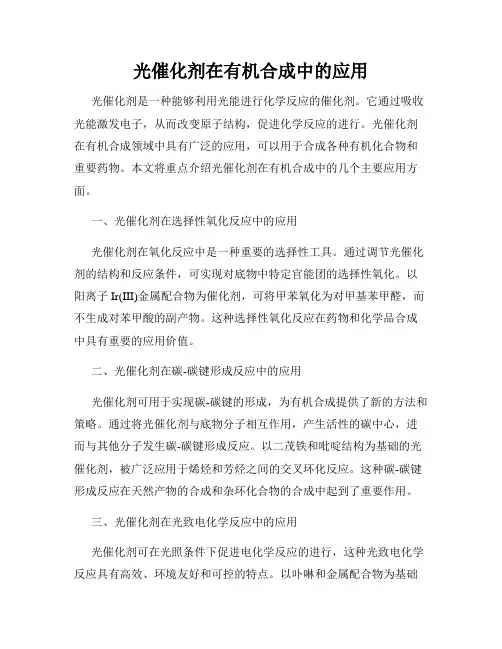
光催化剂在有机合成中的应用光催化剂是一种能够利用光能进行化学反应的催化剂。
它通过吸收光能激发电子,从而改变原子结构,促进化学反应的进行。
光催化剂在有机合成领域中具有广泛的应用,可以用于合成各种有机化合物和重要药物。
本文将重点介绍光催化剂在有机合成中的几个主要应用方面。
一、光催化剂在选择性氧化反应中的应用光催化剂在氧化反应中是一种重要的选择性工具。
通过调节光催化剂的结构和反应条件,可实现对底物中特定官能团的选择性氧化。
以阳离子Ir(III)金属配合物为催化剂,可将甲苯氧化为对甲基苯甲醛,而不生成对苯甲酸的副产物。
这种选择性氧化反应在药物和化学品合成中具有重要的应用价值。
二、光催化剂在碳-碳键形成反应中的应用光催化剂可用于实现碳-碳键的形成,为有机合成提供了新的方法和策略。
通过将光催化剂与底物分子相互作用,产生活性的碳中心,进而与其他分子发生碳-碳键形成反应。
以二茂铁和吡啶结构为基础的光催化剂,被广泛应用于烯烃和芳烃之间的交叉环化反应。
这种碳-碳键形成反应在天然产物的合成和杂环化合物的合成中起到了重要作用。
三、光催化剂在光致电化学反应中的应用光催化剂可在光照条件下促进电化学反应的进行,这种光致电化学反应具有高效、环境友好和可控的特点。
以卟啉和金属配合物为基础的光催化剂,可用于光致电化学水分解产氢反应。
通过光催化剂的作用,可有效提高水分解反应的效率,实现可持续能源的制备。
此外,光催化剂还可用于光致电化学还原反应,促进有机分子的还原转化。
四、光催化剂在金属有机化学中的应用金属有机化学是有机合成领域的重要分支,光催化剂在金属有机化学中发挥着重要的作用。
以铱、钌、铑等金属为中心的光催化剂,可以与底物形成有效的金属有机复合物,进而发生多种重要的C-H键活化反应。
这些反应在有机合成中具有重要的意义,可用于构建复杂有机分子的骨架和引入特定官能团。
总结光催化剂在有机合成中的应用已成为一种重要的研究方向。
通过调节光催化剂的结构和反应条件,可以实现对有机化合物的选择性转化和高效合成。
光催化剂在有机合成中的应用与优化
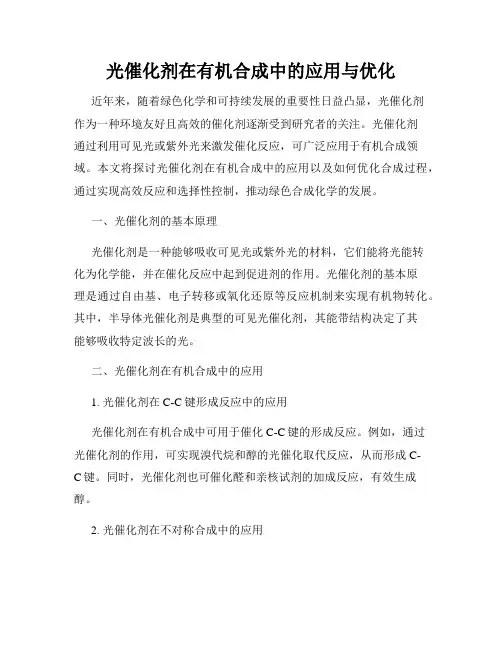
光催化剂在有机合成中的应用与优化近年来,随着绿色化学和可持续发展的重要性日益凸显,光催化剂作为一种环境友好且高效的催化剂逐渐受到研究者的关注。
光催化剂通过利用可见光或紫外光来激发催化反应,可广泛应用于有机合成领域。
本文将探讨光催化剂在有机合成中的应用以及如何优化合成过程,通过实现高效反应和选择性控制,推动绿色合成化学的发展。
一、光催化剂的基本原理光催化剂是一种能够吸收可见光或紫外光的材料,它们能将光能转化为化学能,并在催化反应中起到促进剂的作用。
光催化剂的基本原理是通过自由基、电子转移或氧化还原等反应机制来实现有机物转化。
其中,半导体光催化剂是典型的可见光催化剂,其能带结构决定了其能够吸收特定波长的光。
二、光催化剂在有机合成中的应用1. 光催化剂在C-C键形成反应中的应用光催化剂在有机合成中可用于催化C-C键的形成反应。
例如,通过光催化剂的作用,可实现溴代烷和醇的光催化取代反应,从而形成C-C键。
同时,光催化剂也可催化醛和亲核试剂的加成反应,有效生成醇。
2. 光催化剂在不对称合成中的应用在不对称合成领域,光催化剂广泛用于手性化合物的合成。
以手性光催化剂为例,它们能够在光照条件下催化不对称的有机合成反应,实现产物的对映选择性。
3. 光催化剂在环境修复中的应用光催化剂在环境修复方面具有巨大的潜力。
例如,通过光催化剂的作用,可将有机污染物光催化降解为无害的物质,从而净化水体和大气。
三、光催化剂在有机合成中的优化措施1. 光催化剂的设计与合成合理设计和合成高效的光催化剂是优化有机合成中的关键因素。
研究者可以通过合理选择和组合催化剂的结构,提高催化剂的吸光能力、催化活性和稳定性。
2. 反应条件的优化合理的反应条件对于光催化剂的应用和优化至关重要。
例如,合适的光源选择、温度控制以及反应溶剂的选择等都可以影响催化剂的效率和选择性。
3. 光催化剂与底物之间的相互作用光催化剂与底物之间的相互作用对于实现高效合成具有重要作用。
光催化有机合成的研究与应用
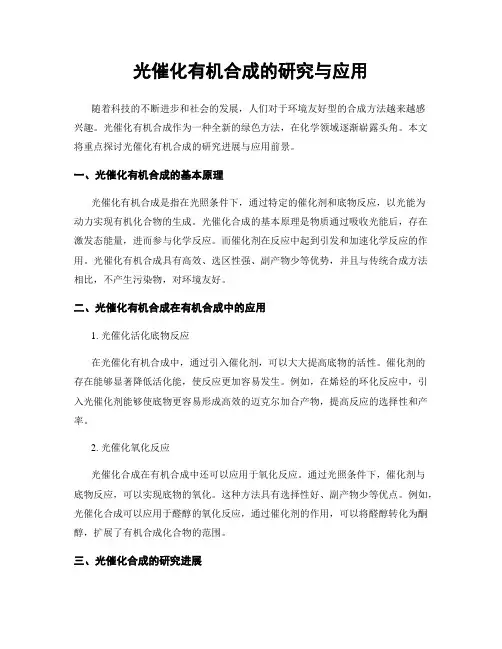
光催化有机合成的研究与应用随着科技的不断进步和社会的发展,人们对于环境友好型的合成方法越来越感兴趣。
光催化有机合成作为一种全新的绿色方法,在化学领域逐渐崭露头角。
本文将重点探讨光催化有机合成的研究进展与应用前景。
一、光催化有机合成的基本原理光催化有机合成是指在光照条件下,通过特定的催化剂和底物反应,以光能为动力实现有机化合物的生成。
光催化合成的基本原理是物质通过吸收光能后,存在激发态能量,进而参与化学反应。
而催化剂在反应中起到引发和加速化学反应的作用。
光催化有机合成具有高效、选区性强、副产物少等优势,并且与传统合成方法相比,不产生污染物,对环境友好。
二、光催化有机合成在有机合成中的应用1. 光催化活化底物反应在光催化有机合成中,通过引入催化剂,可以大大提高底物的活性。
催化剂的存在能够显著降低活化能,使反应更加容易发生。
例如,在烯烃的环化反应中,引入光催化剂能够使底物更容易形成高效的迈克尔加合产物,提高反应的选择性和产率。
2. 光催化氧化反应光催化合成在有机合成中还可以应用于氧化反应。
通过光照条件下,催化剂与底物反应,可以实现底物的氧化。
这种方法具有选择性好、副产物少等优点。
例如,光催化合成可以应用于醛醇的氧化反应,通过催化剂的作用,可以将醛醇转化为酮醇,扩展了有机合成化合物的范围。
三、光催化合成的研究进展光催化有机合成近年来在化学领域取得了长足的发展。
有机化学家们不断研究不同的光催化剂,并且在机理的研究上也取得了一系列的突破。
例如,研究人员发现一些金属有机配合物作为光催化剂能够对光照条件下特定的有机反应起到良好的催化作用。
此外,通过改变催化剂的结构,研究人员发现可以调控反应的速率和产物的选择性,为光催化有机合成的实际应用提供了更好的选择。
四、光催化有机合成的应用前景由于光催化有机合成具有环境友好、高效和选择性强等优势,因此在化学领域具有广阔的应用前景。
首先,光催化有机合成可以用于制备医药、农药和功能性材料等有机化合物。
有机合成中的光催化反应
有机合成中的光催化反应光催化反应是一种利用光能激发物质分子转变的化学反应。
这种反应在有机合成领域中扮演着重要的角色,它能够在温和条件下实现无机试剂的节约以及选择性的提高。
本文将重点介绍有机合成中的光催化反应及其应用。
一、光催化反应的基本原理光催化反应是基于光和物质相互作用的化学反应。
当物质分子吸收光能后,其电子能级将发生变化,从而引发一系列电荷转移和化学反应。
光催化反应的基本原理包括三个方面:1. 光吸收:物质分子吸收合适波长的光能,使其电子从基态跃迁至激发态。
2. 电荷转移:激发态的物质分子将电子转移到其他物质分子,使其发生反应。
3. 化学反应:由于电子转移导致化学键断裂和形成,最终得到产物。
二、有机合成中的光催化反应有机合成中的光催化反应具有很大的应用潜力,其优势主要表现在以下几个方面:1. 温和条件:与传统的热催化反应相比,光催化反应能在温和条件下进行,减少能量消耗和环境影响。
2. 选择性提高:通过合理选择光催化剂和反应条件,可以实现对特定键或官能团的选择性转化,提高有机合成的效率和产率。
3. 无机试剂节约:光催化反应中常使用可再生的光催化剂,而无需使用大量的金属催化剂,这减少了试剂的消耗和环境污染。
三、有机合成中的典型光催化反应1. 光氧化反应:光氧化反应是指有机物在光的作用下与氧气发生反应,主要用于化学合成中的氧化反应。
例如,光氧化反应可以将烯烃转化为烯醇、酮或醛,是合成多种有机化合物的重要方法之一。
2. 光还原反应:光还原反应是指有机物在光的作用下接受外部电子供体的电子,发生还原反应。
光还原反应常用于合成邻苯二酚、酮和烯烃等化合物。
光还原反应的一个典型应用是光催化羧酸的加氢反应,可以高效地催化羧酸的加氢生成醇。
3. 光取代反应:光取代反应是指有机物在光的作用下,通过光引发自由基的生成和化学键的断裂,从而实现有机物的取代反应。
光取代反应常用于合成芳香化合物的取代反应和碳-碳键或碳-氮键的形成。
新型光催化剂在有机合成中的应用及其研究进展
新型光催化剂在有机合成中的应用及其研究进展近年来,光催化技术在有机合成领域得到了广泛应用。
其中一种新型光催化剂——光催化金属有机骨架材料,又称为光催化金属有机框架化合物(MOFs),由于其高效、可重复使用等优势,在一些有机合成反应中展现出了很大的优势。
本文将介绍新型光催化剂在有机合成中的应用及其研究进展。
一、光催化原理在光催化过程中,溶液中的光催化剂吸收入射的光能,并将其转化成化学活性位点上的电子和空穴。
随后,这些电子和空穴在催化剂表面进行自由移动,与反应物或中间体发生反应,从而促进反应的进行。
二、光催化金属有机框架化合物在有机合成中的应用1. 羟基化反应光催化金属有机框架化合物在苯甲醛和1,3-环氧丙烷反应中作为催化剂,可以促使产物的羟基化反应进行。
实验结果表明,光催化金属有机框架化合物Cu-BTC 在水溶液中可以将苯甲醛转化为相关的醇类产物,产率达到了96%。
2. 醇化反应光催化金属有机框架化合物也可以在醇化反应中发挥卓越的催化作用。
比如,将苯甲醛和苯酚加入到光催化金属有机框架化合物MOF-5的溶液中,在紫外光照射约13小时后,可以得到苯甲醇产物,其产率高达83%。
3. 中间体的转化光催化金属有机框架化合物还可以在中间体转化过程中发挥重要作用。
以三苯甲烷为例,光催化金属有机框架化合物MIL-101在紫外光照射下催化三苯甲烷的羟基化反应,得到了C-C键形成的三苯甲烯产物,其收率为75%。
三、光催化金属有机框架化合物研究进展1. MOFs的光催化性质研究因为光催化金属有机框架化合物在光敏化反应中的重要作用,越来越多的研究对MOFs的光催化性质进行深入探究。
一些研究表明,在光催化反应中,MOFs可以发挥比传统光催化剂更高的光催化效果。
同时,MOFs还展现了比传统金属催化剂更高的催化效率和可重复使用性。
2. 基于MOFs的新型光敏化剂的研究为了提高光催化金属有机框架化合物的效率和稳定性,一些研究开始探索基于MOFs的新型光敏化剂的设计。
有机合成中的光催化CC键偶联反应研究
有机合成中的光催化CC键偶联反应研究光催化CC键偶联反应作为有机合成领域的一种重要反应,近年来引起了广泛的研究兴趣。
其独特的特点使得它在有机合成中具有广泛的应用前景。
本文将对光催化CC键偶联反应进行深入研究和探讨,并分析其在有机合成中的应用。
一、光催化CC键偶联反应的基本原理光催化CC键偶联反应是利用光催化剂在可见光的激发下发生的键偶联反应。
其基本原理是,光催化剂通过吸收光能,激发到激发态,并与底物发生反应,最终形成C-C键的连接。
这一反应过程具有较高的原子经济性和高选择性,使得其在有机合成中具有重要的应用价值。
二、光催化CC键偶联反应的研究进展近年来,光催化CC键偶联反应在有机合成领域得到了广泛的研究。
研究人员通过合成不同的光催化剂,调节反应条件和底物结构,实现了一系列高效、高选择性的CC键偶联反应。
本节将对其中几个重要的研究成果进行概述。
首先,以无机光敏剂为例。
研究人员通过合成各种不同的无机光敏剂,如Ru、Ir等,成功实现了多种不同底物的CC键偶联反应。
这些无机光敏剂具有较长的寿命和高度的光稳定性,适用于光催化反应中。
其次,以有机光催化剂为例。
有机光催化剂因其结构多样性和可调性,在光催化CC键偶联反应中也具有重要的应用潜力。
研究人员通过设计合成具有特定结构的有机光催化剂,实现了对底物的高度选择性催化。
例如,利用有机光催化剂可以将烯烃底物与醛底物进行CC键偶联反应,形成C-C键的构建。
另外,研究人员通过改进反应条件,如调节pH、溶剂和光源等,进一步提高了光催化CC键偶联反应的产率和选择性。
例如,将反应条件优化到空气中进行反应,可以避免使用惰性气体,提高反应的可持续性。
三、光催化CC键偶联反应在有机合成中的应用光催化CC键偶联反应具有广泛的应用前景。
其不仅可以构建已有的碳碳键,还可以形成新型的碳碳键,进一步扩展有机合成的化学空间。
光催化CC键偶联反应在天然产物合成中的应用是一个重要方向。
研究人员利用光催化CC键偶联反应成功合成了多种复杂的天然产物分子。
mof光催化在有机合成方面的应用
mof光催化在有机合成方面的应用近年来,光催化技术在有机合成领域得到了广泛的应用,其中以mof光催化技术为代表的新型光催化剂备受关注。
本文将从mof光催化技术的基本原理、有机合成中的应用以及未来的发展方向等方面进行探讨。
一、mof光催化技术的基本原理mof,即金属有机框架,是一种由金属离子和有机配体构成的多孔材料。
mof具有大量的表面积和孔隙结构,因此具有很强的吸附能力和催化活性。
mof光催化技术是指利用mof材料对光能的吸收和转换,进而促使有机反应的发生。
mof光催化技术的基本原理是,利用光能激发mof材料中的电子,使其跃迁到高能级轨道上,形成激发态。
激发态的电子可以参与有机反应的发生,从而加速反应速率,并提高反应的选择性和产率。
另外,mof材料的孔隙结构还可以提供反应物分子的空间排列和定向,进一步促进有机反应的发生。
二、mof光催化技术在有机合成中的应用mof光催化技术在有机合成中的应用非常广泛,可以用于各种有机反应的催化和促进。
以下列举几个具有代表性的案例。
1. 光催化羟甲基化反应羟甲基化反应是一种重要的有机合成反应,可以用于制备醇、醛、酮等化合物。
mof光催化羟甲基化反应可以实现高效、选择性的羟甲基化反应,同时还具有较高的催化活性和稳定性。
2. 光催化芳香烃官能团化反应芳香烃官能团化反应是一种重要的有机合成反应,在制备一些重要有机化合物时具有广泛应用。
mof光催化芳香烃官能团化反应可以实现高效的反应转化率和选择性,还可以避免传统反应中产生的废弃物和有害气体的产生。
3. 光催化偶氮苯类反应偶氮苯类反应是一种具有广泛用途的有机合成反应,在多种领域中都有应用。
mof光催化偶氮苯类反应可以实现高效、选择性的反应转化,同时还可以避免传统反应中使用的有害气体和废弃物的产生。
三、mof光催化技术的未来发展方向随着对mof光催化技术的深入研究,人们对其未来发展方向的探讨也越来越多。
以下列举几个可能的发展方向。
- 1、下载文档前请自行甄别文档内容的完整性,平台不提供额外的编辑、内容补充、找答案等附加服务。
- 2、"仅部分预览"的文档,不可在线预览部分如存在完整性等问题,可反馈申请退款(可完整预览的文档不适用该条件!)。
- 3、如文档侵犯您的权益,请联系客服反馈,我们会尽快为您处理(人工客服工作时间:9:00-18:30)。
Practical synthesis of aromatic amines by photocatalytic reduction of aromatic nitro compounds on nanoparticles N-doped TiO 2Huqun Wang a ,Junping Yan a ,Wenfu Chang b ,Zhimin Zhang a,*a School of Chemistry and Chemical Engineering,Shanxi University,Wucheng Road,Taiyuan 030006,PR China bInstitute of Molecular Science,Shanxi University Taiyuan 030006,PR Chinaa r t i c l e i n f o Article history:Received 9September 2008Received in revised form 15December 2008Accepted 17December 2008Available online 25December 2008Keywords:ReductionAromatic amines N-doped TiO 2Potassium iodidea b s t r a c tA novel efficient method for the catalytic reduction of aromatic nitro compounds to the corresponding amines was reported.Aromatic nitro compounds were chemoselectively reduced to the corresponding amines by using N-doped TiO 2and potassium iodide as photocatalysts in the presence of methanol.The novel method is highly efficient with very short reaction time (<20min),excellent yields (>90%)and wide functional group tolerance such as carbonyl,halogen,amino,hydroxyl and carboxylic acid groups.And N-doped TiO 2was prepared by a modified sol-gel method using urea as nitrogen source and had higher photocatalytic activity comparing with pure TiO 2.The catalysts were characterized by XRD,XPS,TEM and UV–Vis DRS.Ó2009Published by Elsevier B.V.1.IntroductionAromatic amines are widely used key intermediates in the industrial synthesis of dyes,pharmaceuticals and agrochemicals [1].A variety of methods for the direct reduction of aromatic nitro compounds to the corresponding amines has been well docu-mented [2–4].However,development of new methodology espe-cially the environmentally benign process still attracts the great interests in the chemistry community [5–8].In comparison to the commonly used methods which involve hydrogenation,elec-tron transfer and hydride reduction,photocatalytic reduction emerges as cost-effective,highly selective,rapid and environmen-tally friendly.Li and co-workers first reported a photoinduced reduction of nitro compounds to the corresponding amines using TiO 2semiconductor as a catalyst [9].Ferry and co-workers further investigated the mechanism of photocatalytic reduction of nitro aromatics at the surface of titanium dioxide slurries in the pres-ence of the sacrificial electron donor methanol or isopropanol [10].Heterogeneous photocatalysis has been rapidly becoming an exciting and growing area of research due to its direct application for synthetic chemistry,such as Photo–Kolbe oxidation [11],reduc-tion [12],amino acid [13],Diels–Alder [14]and Friedel–Crafts alkylation [15]reactions.However,so far these reactions are still hardly applied to the industrial field.Research in our laboratory has focused in the late few years on new active-TiO 2based reduc-ing systems.The reaction for synthesis of amines from nitro com-pounds was catalyzed by irradiating N-doped TiO 2(N-TiO 2)and potassium iodide in solution of methanol (Scheme 1).The proce-dure of synthesis of aromatic amines was much simpler and more efficient than those in any other literature.In addition,the photo-catalyst could be reused and remained sufficient catalytic activity.2.Experimental2.1.Catalyst preparation and characterizationAll reagents were analytical reagent grade and were used with-out any further purification.A solution of tetrabutyltitanate (8.5mL)in absolute ethanol (30mL)was mixed with glacial acetic acid (1.5mL)as constraining reagent to prevent the precipitation of oxides and stabilize the solution and an ethanol solution of dis-tilled water and urea (EtOH:H 2O:CH 4ON 2=3:48:1)was added to above solution under vigorous stirring.The pH of solution was ad-justed about three by nitric acid.After 3h,the gel so obtained had been left ageing overnight at room temperature to ensure the com-pletion of the hydrolysis,subsequently evaporation of the solvent,drying at 100°C for 8h and finally calcination at 450°C for 4h.The anatase crystal phase was determined from the X-ray diffraction (XRD)patterns obtained by using an X-ray diffractometer (Model D/Max 2550V)with a Cu target Ka-ray (k =1.544178Å).The mor-phology of the N-TiO 2powders was examined by using a Hitachi-600-2transmission electron microscope (TEM)and UV–Vis diffuse reflectance spectrophotometer (Cary 300,Varian,US)was employed to determine the optical properties of N-TiO 2and pure1566-7367/$-see front matter Ó2009Published by Elsevier B.V.doi:10.1016/j.catcom.2008.12.045*Corresponding author.Tel.:+863517010588;fax:+863517011688.E-mail address:mqz1003@ (Z.Zhang).Catalysis Communications 10(2009)989–994Contents lists available at ScienceDirectCatalysis Communicationsjournal homepage:www.elsev i e r.c o m /l o c a t e /c a t c omTiO 2.The surface composition and bonding configuration were measured by XPS in a VG ESCALAB250system.2.2.Photocatalytic synthesis of aromatic aminesPhotocatalytic reactions were carried out in a cylindrical round bottomed quartz photo-reactor and irradiated using 500W high-pressure mercury lamp and solar light under magnetic stirring at room temperature.The reduction of aromatic nitro compounds (1mmol)was carried out in the present of N-TiO 2(10g/L)and potassium iodide (0.3mmol)in methanol (30mL),which was irra-diated for 6–20min.Then while stirring,the reaction mixture be-came heterogeneous as the reaction progressed.The light yellow N-TiO 2was filtered and the filtrate was concentrated to dryness.The crude product was further purified by silica-gel column chro-matography to give the product amines.All products gave HPLC spectra consistent with the spectra of standard.3.Results and discussion3.1.TEM observations and optical properties of N-TiO 2powders Fig.1a shows typical TEM images of anatase N-TiO 2particles.The characterization of catalyst by TEM studies showed that the nanoparticles were well-distributed.The average size of nitrogen doped TiO 2nanoparticles was between 5.20and 13.5nm which were essentially consistent with the XRD result.The size distribu-tion graphic was depicted in Fig.1b.The UV–Vis DRS absorption spectra of N-TiO 2and TiO 2were shown in Fig.2.N-TiO 2sample absorbed more visible light in the range of 400–550nm comparing with pure TiO 2,and the method was effective to shift the optical absorption of N-TiO 2particles to-ward the visible regions.The band gap of sample is determined by the equation E g =1239.8/k [16],where E g (eV)is band gap and k (nm)is the wavelength of the absorption edge in the spectrum.The band gaps obtained optically were approximately 2.85and3.02eV for N-doped TiO 2and TiO 2,respectively,revealing that the band gap of TiO 2was narrowed by N doping.The absorption edge of N-TiO 2was moved to 550nm,resulting in extending the activating spectrum from UV to the visible range.The absorption edge was shifted to the lower-energy region in the spectrum of N-TiO 2.The band gap narrowing in our research may be caused by introduction of nitrogen from urea into the lattice of titanium.Thus,the sample of N-TiO 2showed the excellent visible light absorption,indicating the increase of photocatalytic activity in vis-ible region.3.2.XRD observations and XPS analysisShown in Fig.3were X-ray powder diffraction patterns of TiO 2and N-TiO 2powder samples prepared.From the intensity ratios be-tween the diffraction appearing at 2h =25.5(anatase 101)may conclude that the TiO 2deposited at 450°C consists almost com-pletely of the anatase phase and no other crystal phase can be de-tected.The average crystalline size of N-TiO 2was calculated using the Scherrer equation.Pure TiO 2had a particle size of 10.4nm;doped TiO 2,about 6.80nm.N-doped TiO 2powers showed smaller size than undoped-TiO 2prepared at the same calcinationtemperature.Fig.1.(a)TEM micrograph of N-TiO 2nanoparticles.(b)Size distribution of N-TiO 2nanoparticles determined by TEM.The sizes were determined for 100nanoparticles selected at random.990H.Wang et al./Catalysis Communications 10(2009)989–994Shown in Fig.4were XPS spectra of the as-synthesized N-TiO2 samples.The N1s and Ti2p were found from the XPS patterns of N-TiO2.It could be seen from Fig.4a that the broad N1s peak was found at399.8eV,showing that nitrogen was incorporated into the TiO2.The N feature at a binding energy of396.6eV was mostly assigned as the substitutional incorporation of nitrogen into the TiO2lattice,and the peak at399.8eV was assigned as N A O and N A N bonding,or the nitrogen chemically bound to hydrogen when introduced by N dopants.Chen and Burda[17]ob-served a broad XPS peak centered at401.3eV for their N-doped TiO2nanoparticles and they attributed it to the substitutional O–Ti–N sites in the TiO2lattice.However,the nitrogen state in the doped TiO2may vary form case to case and variations in the XPS results may be associated with the different surface structures. So we could conclude the Ti–O–N bonds had been formed.In the Ti2p region,both the Ti2p2/3and Ti2p1/2were found at461.9 and467.6eV,respectively.According to the XPS standard spec-trum[18],the Ti2p2/3peak of TiO2should be at458.8eV,but from Fig.4b the Ti2p2/3was found at461.9eV,and so,it was confirmed that Ti in N-TiO2did not exist in the form of TiO2only.Miao et al.[19]also assigned these shifted peaks to TiO2Àx N x.Based on the above XPS analysis,the broad N1s feature and the shift of Ti2p peaks in this work provide strong evidence for the substitutional incorporation of nitrogen into the TiO2and the TiO2Àx N x structure was well formed.3.3.Photocatalytic activityThe photocatalytic activity of doped and undoped nanoparticles was investigated by the photocatalytic reduction of o-nitrophenol as a model of reaction.The P25,pure TiO2and N-TiO2were irradi-ated by UV light.Results were shown in Fig.5.Under UV irradia-tion,the yield of photocatalytic synthesis of o-aminophenol was about10%with P25.This was anticipated because the activity of P25had been proved to be very low.However,the yield with N-TiO2was very high(99.27%)after reaction for7.5min,compar-ing with pure TiO2(40.05%).Similarly,we also investigated the photocatalytic activity under solar light and the results were shown in Fig.5.As shown in Fig.5,no reducing products were ob-tained with P25under solar light after300min,while the yield was also very small(3.24%)with pure TiO2in the same time. According to the previous report,pure TiO2had no photocatalytic activity under visible light.So this may be attributed to the pres-ence of ultraviolet in solar light.Then we made the supplement experiment under solar light through UV-cutfilter sheet and the result showed no products were detected on pure TiO2after 300min.The N-TiO2still showed the best catalytic activity among the catalysts under solar light.As a comparison,we also measured the photocatalytic performance of potassium iodide under the same experimental conditions.Nevertheless,no photo-reduction products were obtained with KI alone under UV irradiation.Fur-ther experiments were carried out to confirm whether the reaction was photocatalytic or not and it was observed that no products were formed in the absence of N-TiO2catalyst.It was therefore be-lieved that the interactions between N-TiO2and KI contributed toH.Wang et al./Catalysis Communications10(2009)989–994991992H.Wang et al./Catalysis Communications10(2009)989–994 Table1the superior activity for the reduction of nitroarenes.Based on the experiments above,it was obvious that N-TiO2had higher photo-catalytic activity comparing with pure TiO2and P25,which was as-cribed to the N dopant.This was consistent with the analytical results.According to the XRD analysis,the N dopant of TiO2de-creased the crystalline size of TiO2which resulted in the enhance-ment of photocatalytic activity.According to XPS analysis,the entry of N into the TiO2lattices suppressed the particle growth and consequently caused a decrease of oxygen vacancies,whichminimized the electron-hole recombination during the photocata-lytic synthesis of aromatic amines.3.4.Photocatalytic synthesis of aromatic aminesThe reduction for aromatic nitro compounds has been carried out using the procedure under UV irradiation because of the long reaction time under solar light.Quantitative analysis of the yield for the reaction was performed in triplicate and the standard devi-ation was calculated.The results were listed in Table1.The data presented clearly showed the efficiency of potassium iodide and N-TiO2in the reduction of several nitro compounds.Moreover, the reaction time was much shorter than those reported in any other literature.It could be seen that the reduction of nitroarenes gave corre-sponding amines in excellent yield(above90%).The catalytic sys-tem was efficient in the reduction of aromatic nitro compounds bearing additional substituents in aromatic ring.With regard to the reactivity of the different nitroarenes tested,it was worth not-ing that the electronic properties of substituents attached to the aromatic ring have any effect on the reduction of nitro groups. Moreover,nitro compounds bearing electron-withdrawing groups, which have been reported as more reactive or active when reacted, gave the corresponding amines in better yields and in shorter reac-tion time comparing with that of the aromatic nitro compounds substituted with strong-electron releasing groups.Concerning the steric hindrance effect of nitro groups with substituent at their ortho position,we have observed no adverse affect for the reduc-tive process in the case of ortho substituent that were expected less reactivity such as hydroxyl,methyl and amino at this position and this was inconsistent with the conventional principle.How-ever,as shown in Table1,the meta position required a longer irra-diation time compared with the ortho position and this was also different from what would be expected.The effect of the additives by reduction of o-nitrophenol as a model reaction has been checked out by comparing preliminary yields with additives and without additives.Potassium iodide and sodium iodide were found to be the most effective additives (Table2).Indeed,using an additive could improve the yield of reac-tion.The probable reaction mechanism was shown in Scheme2. With UV or high energy visible light,an excited state iodide ion would be probably produced.This together with the solvent led to the electron cage complex which,in turn,reacts either with an oxidizing agent or a proton donor.In the process of reaction,meth-anol provided the proton and produced the hydrogen radicals, while TiO2produced pairs of electron-holes(eÀ,h+)under irradia-tion,and the iodide anion was oxidized into the iodine by parts of holes.Accordingly,iodide ion was a scavenger that reacts with po-sitive holes,decreasing the number of oxidizing species available on the catalyst surface.However,with the increase of the KI con-centration,iodide anion competed for the adsorptive sites on the N-TiO2surface with o-nitrophenol,resulting in the decrease of yield.With KI alone the reduction reaction didn’t occur and it may be interpreted that the iodide ion was not oxidized into the molecular iodine without conventional oxidant,because the ex-cited state iodide ion would be prone to return the base state.That is,it will be not completely effectively carried out for the reduction of molecular iodine by organic matter,and hence molecular iodine should not appear.4.ConclusionsIn conclusion,we have described herein a new methodology which can efficiently convert aromatic nitro compounds in metha-nol using N-TiO2and potassium iodide,under more facile and inex-pensive conditions than those described in a previous work.The reagent system described here has been proved to be a good alter-native to well known methods of reduction of aromatic nitro com-pounds.Most interestingly the N-TiO2photocatalyst is stable and reusable under photo-irradiation in the repeated experiments.No meaningful difference in reaction yields is observed in the three re-peated photo-reduction experiments.New applications of this reducing process are being developed.HPLC yield.b SD,standard deviation.Table2Reduction of o-nitrophenol with N-TiO2in the presence of additives(n=3).Entry Additive Reaction time(min)Yield a(mean±SD b)(%)17Without additive1095.47±0.3518KI7.599.27±0.2119KBr1194.90±0.2620NaI7.599.30±0.3621NaBr1093.70±0.8222Na2SO41095.07±0.1223C6H7SO3Na1294.73±0.25a HPLC yield.b SD,standard deviation.H.Wang et al./Catalysis Communications10(2009)989–994993AcknowledgementsWe thank the Science and Technology of Shanxi Province,China (Project No.2006031141)forfinancial assistance and nature sci-ence fund of Shanxi University.References[1]J.S.D.Kumar,M.H.ManKit,T.Toyokuni,Tetrahedron Lett.42(2001)5601.[2]C.Kazmierski,J.M.P.Gosmini,J.Périchon,Tetrahedron Lett.44(2003)6417.[3]Y.Moglie,C.Vitale,G.Radivoy,Tetrahedron Lett.49(2008)1828.[4]U.Stéphane,A.Falguières,A.Guy,C.Ferroud,Tetrahedron Lett.46(2005)5913–5917.[5]A.R.Gandhe,J.B.Fernandes,Bull.Catal.Soc.India4(2005)31.[6]T.C.Jagadale,S.P.Takale,R.S.Sonawane,et al.,J.Phys.Chem.C112(2008)14595.[7]M.Sathish,B.Viswanathan,R.P.Viswanath,Appl.Catal.B:Environ.74(2007)307.[8]K.Abiraj,G.R.Srinivasa,D.C.Gowda,Aust.J.Chem.58(2005)149.[9]F.Mahdavi,T.C.Bruton,Y.Z.Li,.Chem.58(1993)744.[10]L.John,H.G.FerryWilliam,Langmuir14(1998)3551.[11]B.Kraeutler,A.J.Bard,J.Am.Chem.Soc.100(1978)2239.[12](a)L.Lin,R.R.Kuntz,Langmuir8(1992)870.[13](a)W.W.Dunn,Y.Aikawa, A.J.Bard,J.Am.Chem.Soc.103(1981)6893.[14]W.Zhang,X.D.Jia,L.Yang,Z.L.Liu,Tetrahedron Lett.43(2002)9433.[15]M.L.Kantam,ha,J.Yadav, B.Sreedhar,Tetrahedron Lett.47(2006)6213.[16]K.S.Rane,R.Mhalsiker,S.Yin,T.Sato,K.Cho,E.Dunbar,P.Biswas,J.Solid StateChem.179(2006)3033.[17]X.Chen,C.Burda,J.Phys.Chem.B108(2004)15446.[18]Y.Liu,D.Z.Sun,Appl.Catal.B:Environ.72(2007)205.[19]L.Miao,S.Tanemura,H.Watanabe,Y.Mori,K.Kaneko,S.Toh,J.Cryst.Growth260(2004)118.994H.Wang et al./Catalysis Communications10(2009)989–994。
